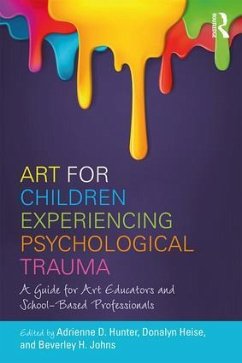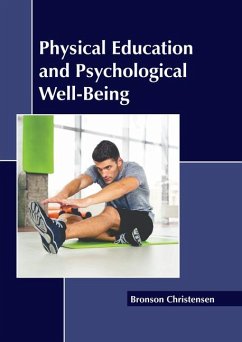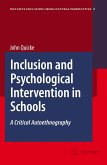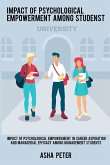Art for Children Experiencing Psychological Trauma
A Guide for Art Educators and School-Based Professionals
Herausgeber: Hunter, Adrienne D.; Johns, Beverley H.; Heise, Donalyn
Art for Children Experiencing Psychological Trauma
A Guide for Art Educators and School-Based Professionals
Herausgeber: Hunter, Adrienne D.; Johns, Beverley H.; Heise, Donalyn
- Broschiertes Buch
- Merkliste
- Auf die Merkliste
- Bewerten Bewerten
- Teilen
- Produkt teilen
- Produkterinnerung
- Produkterinnerung
Art for Children Experiencing Psychological Trauma aims to increase understanding of art's potential to enhance learning for children living in crisis. In this ground-breaking resource, the first of its kind to focus specifically on the connection between art education and psychological trauma in youth populations, readers can find resources and practical strategies for both teachers and other school-based professionals. Also included are successful models of art education for diverse populations, with specific attention to youth who face emotional, mental, behavioral, and physical challenges,…mehr
Andere Kunden interessierten sich auch für
![Psychological Factors and Their Effect on the Health, Well-Being and Performance of Athletes Psychological Factors and Their Effect on the Health, Well-Being and Performance of Athletes]() Psychological Factors and Their Effect on the Health, Well-Being and Performance of Athletes74,99 €
Psychological Factors and Their Effect on the Health, Well-Being and Performance of Athletes74,99 €![Physical Education and Psychological Well-Being Physical Education and Psychological Well-Being]() Physical Education and Psychological Well-Being155,99 €
Physical Education and Psychological Well-Being155,99 €![Physical Education and Sport: A Psychological Perspective Physical Education and Sport: A Psychological Perspective]() Physical Education and Sport: A Psychological Perspective159,99 €
Physical Education and Sport: A Psychological Perspective159,99 €![Inclusion and Psychological Intervention in Schools Inclusion and Psychological Intervention in Schools]() John QuickeInclusion and Psychological Intervention in Schools77,99 €
John QuickeInclusion and Psychological Intervention in Schools77,99 €![Impact of psychological empowerment in career aspiration and managerial efficacy among management students Impact of psychological empowerment in career aspiration and managerial efficacy among management students]() Asha PeterImpact of psychological empowerment in career aspiration and managerial efficacy among management students49,99 €
Asha PeterImpact of psychological empowerment in career aspiration and managerial efficacy among management students49,99 €![Sex Ratio Impacts Psychological Health Sex Ratio Impacts Psychological Health]() Roy P. HenrySex Ratio Impacts Psychological Health24,99 €
Roy P. HenrySex Ratio Impacts Psychological Health24,99 €![Experiencing the story Experiencing the story]() Verónica Rocio Cóndor MendozaExperiencing the story37,99 €
Verónica Rocio Cóndor MendozaExperiencing the story37,99 €-
-
-
Art for Children Experiencing Psychological Trauma aims to increase understanding of art's potential to enhance learning for children living in crisis. In this ground-breaking resource, the first of its kind to focus specifically on the connection between art education and psychological trauma in youth populations, readers can find resources and practical strategies for both teachers and other school-based professionals. Also included are successful models of art education for diverse populations, with specific attention to youth who face emotional, mental, behavioral, and physical challenges, as well a framework for meaningful visual arts education for at-risk/in-crisis populations.
Hinweis: Dieser Artikel kann nur an eine deutsche Lieferadresse ausgeliefert werden.
Hinweis: Dieser Artikel kann nur an eine deutsche Lieferadresse ausgeliefert werden.
Produktdetails
- Produktdetails
- Verlag: Routledge
- Seitenzahl: 322
- Erscheinungstermin: 24. April 2018
- Englisch
- Abmessung: 229mm x 152mm x 17mm
- Gewicht: 469g
- ISBN-13: 9781138236950
- ISBN-10: 1138236950
- Artikelnr.: 52525082
- Herstellerkennzeichnung
- Libri GmbH
- Europaallee 1
- 36244 Bad Hersfeld
- gpsr@libri.de
- Verlag: Routledge
- Seitenzahl: 322
- Erscheinungstermin: 24. April 2018
- Englisch
- Abmessung: 229mm x 152mm x 17mm
- Gewicht: 469g
- ISBN-13: 9781138236950
- ISBN-10: 1138236950
- Artikelnr.: 52525082
- Herstellerkennzeichnung
- Libri GmbH
- Europaallee 1
- 36244 Bad Hersfeld
- gpsr@libri.de
Adrienne D. Hunter, MEd, has over 35 years of experience teaching art to at-risk, in-crisis, and/or incarcerated youth. She is a national presenter, a past president of the interest group on Special Needs in Art Education (SNAE) within the National Art Education Association, and a past membership co-chair for the Council for Exceptional Children¿s Division of Visual and Performing Arts Education (DARTS). Donalyn Heise, EdD, is founder and co-director of Teacher Effectiveness for Art Learning (TEAL), and is a leader at the local, state, and national level. She is a researcher, author, national presenter, and award-winning educator with more than 30 years of experience teaching art to youth who have experienced psychological trauma. Beverley H. Johns, MS, is a professional fellow at MacMurray College. She has worked in public schools with students with significant behavioral problems for more than 33 years, presented international workshops, and authored more than 20 special education books.
I. Overview of Behaviors: Who Are the Children in Crisis? Definitions and Demographics 1. Introduction and Purpose of this Book
Adrienne D. Hunter
Donalyn Heise
and Beverley H. Johns 2. Children Exposed to Trauma: Children in Crisis
Lisa Kay 3. Who Are Homeless Children? Dona Anderson and Matthew Adams 4. Abuse: Signs and Reporting Procedures: What the Art Teacher Should Know
Oriana C. Hunter
Donalyn Heise
Beverley H. Johns
and Adrienne D. Hunter 5. Behavioral Characteristics of Children Living in Crisis and the Impact on Learning
Beverley H. Johns 6. LGBTQ Trauma + Art Education
Mindi Rhoades 7. The Role of the Art Educator in Meeting the Needs of Students Who Are Victims of Human Trafficking
Beverley H. Johns and Adrienne D. Hunter 8. Alternative Educational Services for Students Who Have Experienced Psychological Trauma
Athena Petrolias
Beverley H. Johns
and Adrienne D. Hunter 9. Mental Health Issues and the Art Classroom
Steven Kelly and Darla Dawn Absher 10. Neurobiological Impact of Trauma
Carlomagno Panlilio
Elizabeth Hlavek
and Amanda Ferrara II. Art Education in Practice 11. Creating a Safe and Supportive Classroom Environment
Beverley H. Johns
Donalyn Heise
and Adrienne D. Hunter 12. Routines
Relations
and Reinforcement
Kari Caddell 13. Integrating Art and Academics: A Collaborative Approach
Donalyn Heise
Adrienne D. Hunter
and Beverley H. Johns 14.Building Relationships through Art: Understanding the Potential for Art Making for Students Experiencing Psychological Trauma
Lisa Kay and Sue Loesl 15. Yellow Bricks: An Approach to Art Teaching
Lisa Kay 16. Non-Traditional Educational Settings
Center Schools
and Students with Behavioral Disorders
Joseph A. Parsons
Adrienne D. Hunter
and Donalyn Heise 17. Art and Youth Who Are Incarcerated
Adrienne D. Hunter
Beverley H. Johns
and Donalyn Heise 18. Where have we come from? Who are we? Where are we going?: A Ceramic Mural for and by Students of the Rhode Island Training School
Peter J. Geisser 19. Prison Art ¿ A Recreational Model
AnneMarie Swanlek
Beverley H. Johns
and Adrienne D. Hunter III. Identifying Future Directions 20. Pre-Service Art Teacher Preparation and Professional Development
Juliann Dorff
Lisa Kay
Lynne Horoschak
and Donalyn Heise 21. Community Based Art Programs
Collaborative Partnerships
and Community Resources for At-Risk Students
Laura Bailey Saulle
Joseph Lagana
Robin Crawford
and Barbara Duffield 22. The Deep Joy of Teaching Art to Students Who Experience Psychological Trauma
Lynne Horoschak
Adrienne D. Hunter
Donalyn Heise
and Beverley H. Johns 2. Children Exposed to Trauma: Children in Crisis
Lisa Kay 3. Who Are Homeless Children? Dona Anderson and Matthew Adams 4. Abuse: Signs and Reporting Procedures: What the Art Teacher Should Know
Oriana C. Hunter
Donalyn Heise
Beverley H. Johns
and Adrienne D. Hunter 5. Behavioral Characteristics of Children Living in Crisis and the Impact on Learning
Beverley H. Johns 6. LGBTQ Trauma + Art Education
Mindi Rhoades 7. The Role of the Art Educator in Meeting the Needs of Students Who Are Victims of Human Trafficking
Beverley H. Johns and Adrienne D. Hunter 8. Alternative Educational Services for Students Who Have Experienced Psychological Trauma
Athena Petrolias
Beverley H. Johns
and Adrienne D. Hunter 9. Mental Health Issues and the Art Classroom
Steven Kelly and Darla Dawn Absher 10. Neurobiological Impact of Trauma
Carlomagno Panlilio
Elizabeth Hlavek
and Amanda Ferrara II. Art Education in Practice 11. Creating a Safe and Supportive Classroom Environment
Beverley H. Johns
Donalyn Heise
and Adrienne D. Hunter 12. Routines
Relations
and Reinforcement
Kari Caddell 13. Integrating Art and Academics: A Collaborative Approach
Donalyn Heise
Adrienne D. Hunter
and Beverley H. Johns 14.Building Relationships through Art: Understanding the Potential for Art Making for Students Experiencing Psychological Trauma
Lisa Kay and Sue Loesl 15. Yellow Bricks: An Approach to Art Teaching
Lisa Kay 16. Non-Traditional Educational Settings
Center Schools
and Students with Behavioral Disorders
Joseph A. Parsons
Adrienne D. Hunter
and Donalyn Heise 17. Art and Youth Who Are Incarcerated
Adrienne D. Hunter
Beverley H. Johns
and Donalyn Heise 18. Where have we come from? Who are we? Where are we going?: A Ceramic Mural for and by Students of the Rhode Island Training School
Peter J. Geisser 19. Prison Art ¿ A Recreational Model
AnneMarie Swanlek
Beverley H. Johns
and Adrienne D. Hunter III. Identifying Future Directions 20. Pre-Service Art Teacher Preparation and Professional Development
Juliann Dorff
Lisa Kay
Lynne Horoschak
and Donalyn Heise 21. Community Based Art Programs
Collaborative Partnerships
and Community Resources for At-Risk Students
Laura Bailey Saulle
Joseph Lagana
Robin Crawford
and Barbara Duffield 22. The Deep Joy of Teaching Art to Students Who Experience Psychological Trauma
Lynne Horoschak
I. Overview of Behaviors: Who Are the Children in Crisis? Definitions and Demographics 1. Introduction and Purpose of this Book
Adrienne D. Hunter
Donalyn Heise
and Beverley H. Johns 2. Children Exposed to Trauma: Children in Crisis
Lisa Kay 3. Who Are Homeless Children? Dona Anderson and Matthew Adams 4. Abuse: Signs and Reporting Procedures: What the Art Teacher Should Know
Oriana C. Hunter
Donalyn Heise
Beverley H. Johns
and Adrienne D. Hunter 5. Behavioral Characteristics of Children Living in Crisis and the Impact on Learning
Beverley H. Johns 6. LGBTQ Trauma + Art Education
Mindi Rhoades 7. The Role of the Art Educator in Meeting the Needs of Students Who Are Victims of Human Trafficking
Beverley H. Johns and Adrienne D. Hunter 8. Alternative Educational Services for Students Who Have Experienced Psychological Trauma
Athena Petrolias
Beverley H. Johns
and Adrienne D. Hunter 9. Mental Health Issues and the Art Classroom
Steven Kelly and Darla Dawn Absher 10. Neurobiological Impact of Trauma
Carlomagno Panlilio
Elizabeth Hlavek
and Amanda Ferrara II. Art Education in Practice 11. Creating a Safe and Supportive Classroom Environment
Beverley H. Johns
Donalyn Heise
and Adrienne D. Hunter 12. Routines
Relations
and Reinforcement
Kari Caddell 13. Integrating Art and Academics: A Collaborative Approach
Donalyn Heise
Adrienne D. Hunter
and Beverley H. Johns 14.Building Relationships through Art: Understanding the Potential for Art Making for Students Experiencing Psychological Trauma
Lisa Kay and Sue Loesl 15. Yellow Bricks: An Approach to Art Teaching
Lisa Kay 16. Non-Traditional Educational Settings
Center Schools
and Students with Behavioral Disorders
Joseph A. Parsons
Adrienne D. Hunter
and Donalyn Heise 17. Art and Youth Who Are Incarcerated
Adrienne D. Hunter
Beverley H. Johns
and Donalyn Heise 18. Where have we come from? Who are we? Where are we going?: A Ceramic Mural for and by Students of the Rhode Island Training School
Peter J. Geisser 19. Prison Art ¿ A Recreational Model
AnneMarie Swanlek
Beverley H. Johns
and Adrienne D. Hunter III. Identifying Future Directions 20. Pre-Service Art Teacher Preparation and Professional Development
Juliann Dorff
Lisa Kay
Lynne Horoschak
and Donalyn Heise 21. Community Based Art Programs
Collaborative Partnerships
and Community Resources for At-Risk Students
Laura Bailey Saulle
Joseph Lagana
Robin Crawford
and Barbara Duffield 22. The Deep Joy of Teaching Art to Students Who Experience Psychological Trauma
Lynne Horoschak
Adrienne D. Hunter
Donalyn Heise
and Beverley H. Johns 2. Children Exposed to Trauma: Children in Crisis
Lisa Kay 3. Who Are Homeless Children? Dona Anderson and Matthew Adams 4. Abuse: Signs and Reporting Procedures: What the Art Teacher Should Know
Oriana C. Hunter
Donalyn Heise
Beverley H. Johns
and Adrienne D. Hunter 5. Behavioral Characteristics of Children Living in Crisis and the Impact on Learning
Beverley H. Johns 6. LGBTQ Trauma + Art Education
Mindi Rhoades 7. The Role of the Art Educator in Meeting the Needs of Students Who Are Victims of Human Trafficking
Beverley H. Johns and Adrienne D. Hunter 8. Alternative Educational Services for Students Who Have Experienced Psychological Trauma
Athena Petrolias
Beverley H. Johns
and Adrienne D. Hunter 9. Mental Health Issues and the Art Classroom
Steven Kelly and Darla Dawn Absher 10. Neurobiological Impact of Trauma
Carlomagno Panlilio
Elizabeth Hlavek
and Amanda Ferrara II. Art Education in Practice 11. Creating a Safe and Supportive Classroom Environment
Beverley H. Johns
Donalyn Heise
and Adrienne D. Hunter 12. Routines
Relations
and Reinforcement
Kari Caddell 13. Integrating Art and Academics: A Collaborative Approach
Donalyn Heise
Adrienne D. Hunter
and Beverley H. Johns 14.Building Relationships through Art: Understanding the Potential for Art Making for Students Experiencing Psychological Trauma
Lisa Kay and Sue Loesl 15. Yellow Bricks: An Approach to Art Teaching
Lisa Kay 16. Non-Traditional Educational Settings
Center Schools
and Students with Behavioral Disorders
Joseph A. Parsons
Adrienne D. Hunter
and Donalyn Heise 17. Art and Youth Who Are Incarcerated
Adrienne D. Hunter
Beverley H. Johns
and Donalyn Heise 18. Where have we come from? Who are we? Where are we going?: A Ceramic Mural for and by Students of the Rhode Island Training School
Peter J. Geisser 19. Prison Art ¿ A Recreational Model
AnneMarie Swanlek
Beverley H. Johns
and Adrienne D. Hunter III. Identifying Future Directions 20. Pre-Service Art Teacher Preparation and Professional Development
Juliann Dorff
Lisa Kay
Lynne Horoschak
and Donalyn Heise 21. Community Based Art Programs
Collaborative Partnerships
and Community Resources for At-Risk Students
Laura Bailey Saulle
Joseph Lagana
Robin Crawford
and Barbara Duffield 22. The Deep Joy of Teaching Art to Students Who Experience Psychological Trauma
Lynne Horoschak








